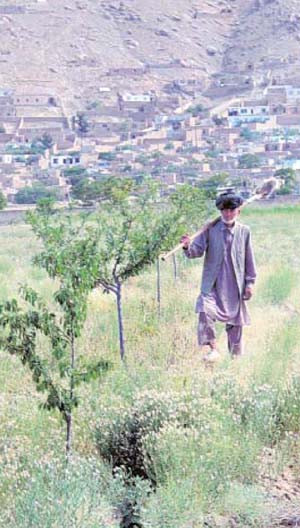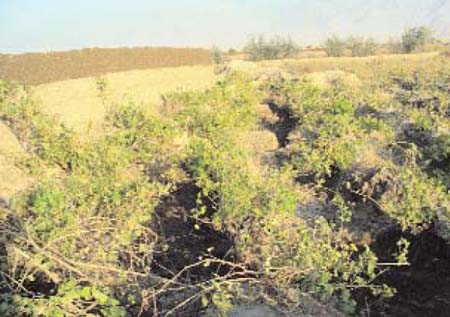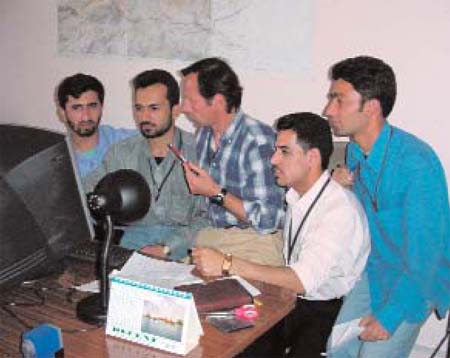
G. DE BAC

G. DE BAC
The survey was conducted in three distinct phases according to the timeframe of the consultants’ missions, the project take-off and the seasons. The onset of spring was the ideal time to launch the large national survey of the horticulture sector.
The survey was conducted in selected villages, chosen according to data gathered from FAO (land cover map and information), from the Ministry of Agriculture and Animal Husbandry (MAAH) and from the Vulnerability Analysis and Mapping (VAM) Unit of the World Food Programme (WFP). The selection of villages for the national survey was made randomly, taking the most traditional areas of fruit production into consideration. Six to seven villages for each of the 329 districts were chosen for a total of about 1 800 villages.
The country was divided into seven regions in order to more efficiently manage the conducting of the survey at the field level. This required seven teams composed of a Regional Coordinator and three field researchers for each of the 32 provinces surveyed. These areas or subregions were assigned to the appointed National Professional Project Personnel (NPPPs).
The three phases were implemented as follows:
|
Designated survey regions within Afghan provinces |
|
|
REGION |
PROVINCES |
|
North |
Faryab, Jawzjan, Saripul, Balkh |
|
North-east |
Baghlan, Samanghan, Kunduz, Takhar, Badakhshan |
|
West |
Badghis, Hirat, Ghor, Farah, Nimroz |
|
East central |
Kabul, Parwan, Kapisa, Ghazni, Logar, Wardak, Bamyan |
|
South-east |
Nangarhar, Kunar, Laghman, Nuristan |
|
South |
Khost, Paktya, Paktika |
|
South-west |
Zabul, Kandahar, Uruzghan, Helmand |
Sub-Phase (a)
A national survey was conducted of all nucleus fruit nurseries, national research stations and private nurseries. Private nurseries were selected according to data gathered from previous FAO horticultural projects in Afghanistan.
Organization and management
The survey was organized and launched by one international horticulture survey specialist and a national horticulture survey coordinator.
Questionnaires were prepared and translated into the Dari and Pashto languages.
A team of regional field survey coordinators was established. Priority was given to the MAAH personnel when available.
Coordination was established with FAO Area Managers to facilitate logistics and the placement of field researchers.
Computers and adequate support were provided for data entry and analysis and communication facilities were procured.
Sub-Phase (b)
A test survey was conducted of the horticulture sector in Kabul Province, Nangarhar Province and Khost Province. It was conducted in at least five villages for each district in each province. A range of between five to seven villages for each district was monitored by the survey.
Organization and management
District level field researchers (9-11) were recruited and trained for about 10-20 days.
Each appointed field researcher had to be familiar with the area to be surveyed.
The FAO Area Manager assisted in providing logistical support in the targeted areas.
The questionnaire translated in Dari and Pashto was tested in Kabul Province.
In the district where private nurseries are present and still active, at least three villages of the five to seven villages monitored were chosen to be surveyed according to their vicinity to the private nurseries.
Collection of data and information for the test and fruit nursery surveys was implemented in December 2002.
Data entry and analysis of Phase I nursery survey results were conducted in January 2003.
Following the results of the test survey, questionnaires were reviewed. The National Horticultural Survey at the village level was then prepared and launched on February 2003.
Results of Phase I (a) and (b) of the survey were analysed.
Organization and management
One international horticulture survey specialist and a national horticulture survey coordinator launched and supervised the National Horticulture Survey and finalized the baseline study (6 weeks).
A team of regional field survey coordinators (8 nationals) was established.
District level field researchers (87) were recruited and trained for 22 days; most of them were assigned to the province where they reside.
The FAO Emergency Area Manager assisted in providing logistical support in the targeted areas.
Data entry and analysis of results of the national horticulture survey (Phase II) were completed.
Organization and management
One international horticulture survey specialist finalized the baseline study (1 month); three to four clerks (3 months each) worked on data computerization and processing.
The main data collection tools were the questionnaires and notebooks for the field researchers’ remarks.
The questionnaire forms were prepared in English and translated into Dari and Pashto. The questions are shown in Annex II.
Field researchers’ remarks were used to obtain additional information not included in the questionnaire for debriefing purposes.
A team of three field researchers was assigned to each province. Following meetings and discussions previously held with provincial authorities, local guides were provided by the District Administration through consultation with the Provincial Shura (Council) or another designated liaison institution.
The criteria for selecting a target community for questionnaire completion were representative groups of 30 to 100 families who cultivated an identifiable geographical area.
Each field researcher used one questionnaire form per village. One village usually consisted of between 30 to 100 families. According to the size of the village a representative group of five to ten readily available and knowledgeable farmers residing were interviewed through group discussions.
For a village of over 100 families, there were usually sub-groups within the community. In these instances, one or more questionnaires were filled out by the field researcher according to the number of sub-groups.

R. DEL CIMA
Villages with less than 30 families were combined with neighbouring families to meet the criteria for completing the questionnaires. Exceptions arose where a village was smaller than 30 families and was located at a considerable distance from a neighbouring village. In such cases, exceptions to group criteria could be made. Exceptions were also made in the case of villages larger than 100 families that could not be divided into separate units because the agricultural land of the village could not be partitioned into separate sub-groups; doing so would have risked overestimating the total land area.
The group selected for the interview possessed sound local knowledge of the cultivated land of the area and its communities.
The field researchers marked the villages monitored on the district maps provided by the Afghanistan Information Management Service (AIMS), which were returned to FAO at the end of the assignment in order to facilitate data crosschecking. All the new codes and selected villages were therefore matched and updated according to the AIMS maps and data system.
Field surveys were monitored and assisted by FAO horticultural national staff to ensure the accuracy of the interviews conducted. Each completed questionnaire was checked and verified in the field to maintain high levels of accuracy. A random check was performed in 10 provinces and in a total of almost 30 districts for verification before computer data entries were made. Moreover, field researchers were debriefed by the Regional Survey Coordinators following their return from the field to extract all necessary information pertaining to the districts surveyed.
Method of data analysis
The data collected were entered in a Microsoft Access database to facilitate further processing and analysis. The data entries were also checked and verified before processing for final analysis purposes. Microsoft Excel was also used for the database analysis.
Methodology limitations and possible causes of errors
The data collection and entry are inevitably subject to minor causes of errors, despite accurate crosschecks conducted at both the field level and during data computerization.
Some of these causes are as follows:
Most of cultivated land cannot be physically measured and all figures quoted by farmers must be considered as estimates only.
While the group interview is a useful method for conducting large-scale surveys, this approach can prevent all members of the group from having an equal opportunity to express their views, and some individuals’ opinions can be influenced by the group.
It should nevertheless be mentioned that the field survey was conducted in more than 1 800 villages from 99 percent of the districts and all provinces. Therefore, even with some minor errors, the figures remain highly representative of the condition of the horticulture sector in Afghanistan.